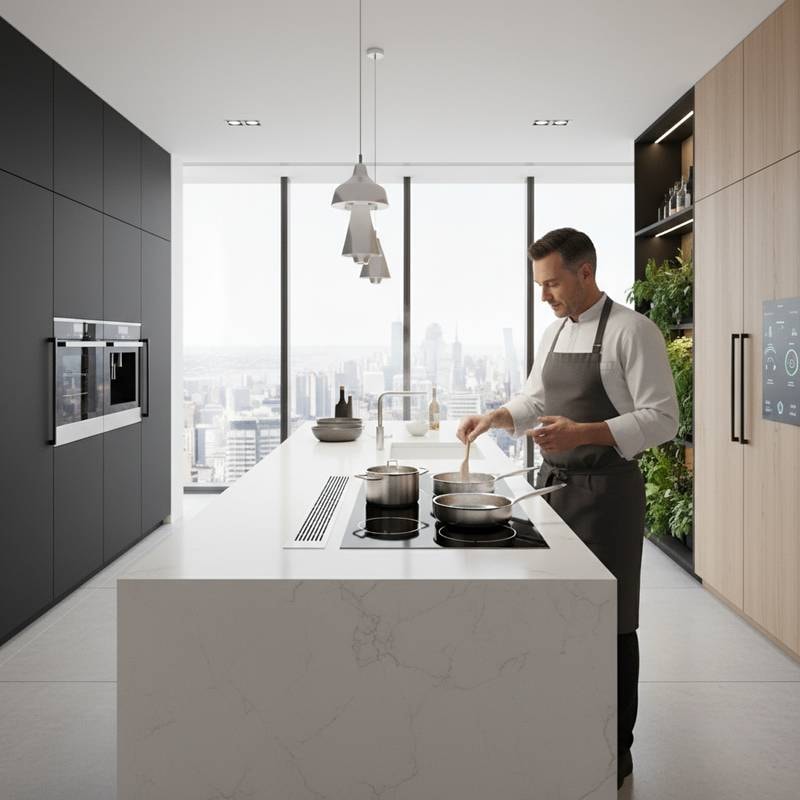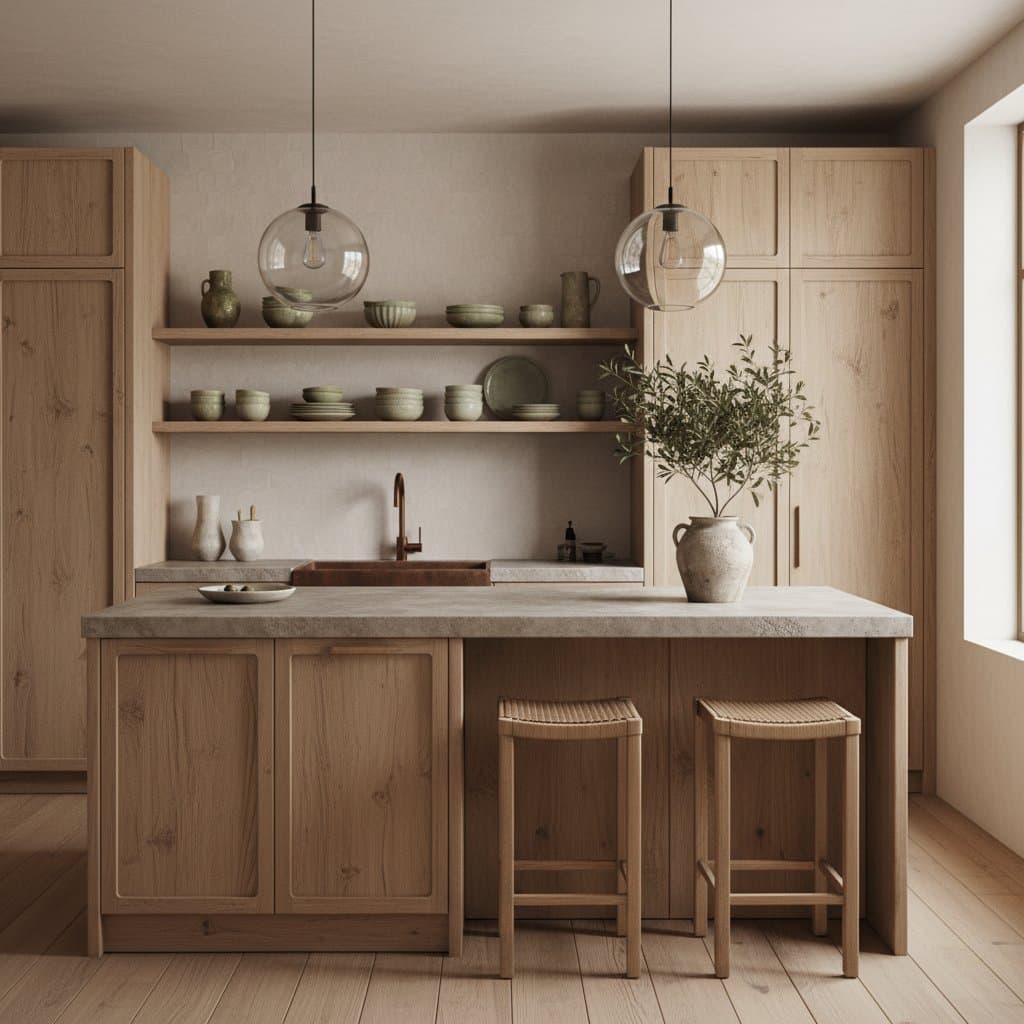The Rise of Induction Cooktops in 2025 Kitchens
Cooking transforms kitchens into dynamic spaces where precision meets creativity. A significant change is underway as induction cooktops surpass traditional gas stoves. This technology uses electromagnetic fields to heat cookware directly, offering enhanced control, safety, and integration with contemporary design.
The transition reflects evolving priorities in home life. Homeowners seek efficient, sustainable solutions that align with modern aesthetics. Induction cooktops, once common in professional settings, now define mainstream kitchens through their seamless blend of form and function.
Aesthetic Integration and Minimalist Design
Induction cooktops enhance visual harmony with their flush, glass surfaces. Designers such as Kelly Wearstler and Vincent Van Duysen incorporate these elements for a clean, understated look. A satin-finish black ceramic-glass top integrates smoothly with countertops like honed Bianco Carrara marble or brushed brass accents.
This design creates serene spaces where light interacts subtly with surrounding materials. The cooktop acts as a neutral canvas, allowing textures from cabinetry and fixtures to stand out. When not in use, the surface doubles as additional counter space, supporting multifunctional islands for prep, dining, and socializing.
Superior Heat Control for Culinary Precision
Induction provides rapid, accurate temperature adjustments. Heat transfers directly to the pan via magnetic fields, enabling quick responses to changes. This prevents issues like overcooked sauces or uneven melting, ensuring consistent results in dishes such as risotto or delicate chocolates.
Professional chefs, including Dominique Crenn, value this intentional control over gas flames. The cooktop surface cools immediately after removing cookware, reducing burn risks in family-oriented or open layouts. Such features make induction ideal for both novice and expert cooks.
Improved Air Quality and Acoustic Comfort
Induction eliminates combustion byproducts, fostering cleaner indoor environments. Gas stoves release nitrogen dioxide and particulates, but induction avoids these entirely. This leads to better air quality without extensive ventilation needs.
The operation is nearly silent, with only a soft hum during use. Architect Lisa McFadden from Studio LM Interiors highlights how this supports quiet, connected living areas. Simplified venting options, like downdraft systems, maintain open sightlines and a lighter atmosphere.
Sustainability Through Energy Efficiency
Induction maximizes energy use by directing nearly all power to the cookware. Unlike gas, which dissipates heat into the air, this method boils water faster and keeps kitchens cooler. Integration with solar or electric grids reduces fossil fuel dependence.
Architectural designer Elena Ruiz of Atelier Verde views this choice as an ethical commitment. Homeowners align their spaces with environmental goals, combining efficiency with thoughtful design. The result supports sustainable living without sacrificing performance.
Material Pairings and Textural Harmony
The cool, smooth induction surface complements diverse materials. Designers pair it with quartzite slabs, limestone, or plaster finishes that gas setups might damage. Cabinetry in matte shades like Farrow and Ball's Railings or Benjamin Moore's Kendall Charcoal enhances the dark glass sheen.
Warm elements, such as European oak or bleached ash, add balance. Textures from satin lacquer, brushed nickel, or suede stone create visual depth. This interplay fosters layered, inviting kitchens tailored to individual styles.
Flexible Layouts for Modern Living
Electrical requirements simplify installation compared to gas lines. This freedom enables creative placements, like cooking zones on islands without bulky vents. Compact spaces benefit from modular setups, such as two-burner units near windows.
Interior architect James Porter of Form+Field Design emphasizes how induction blurs boundaries between cooking and living areas. Distributed surfaces promote social, adaptable workflows. Kitchens evolve into fluid environments that accommodate shared activities.
Hybrid Configurations for Versatility
Some setups combine induction with gas for specialized tasks, like wok cooking. Brands such as Gaggenau, Miele, and Bora offer modular systems that unify both in one surface. This balances tradition with modern efficiency.
Visual contrasts, like matte induction beside stainless burners, add interest. Such designs cater to diverse culinary needs while preserving clean aesthetics. Homeowners achieve personalized functionality without disruption.
Seamless Smart Home Integration
Advanced induction models connect with apps, smart pans, and ventilation. Touch controls and sensors enable programmed temperatures for recipes. This creates an intelligent kitchen ecosystem responsive to user needs.
Designers balance tech with organic touches, like hand-glazed ceramics or linen stools. Natural materials and soft lighting maintain warmth amid precision. The result is a human-centered space that enhances daily routines.
Cultural Evolution in Kitchen Design
Induction signifies a shift toward mindful, adaptable living. Younger generations, influenced by urban gas restrictions, embrace it as standard. Kitchens express values of restraint and sustainability over ostentation.
This trend redefines luxury through quiet performance. Designers craft spaces that prioritize flow and participation, dissolving traditional hierarchies. Cooking becomes a collaborative, intentional practice.
Embracing Induction in Daily Use
Adopting induction requires compatible cookware, such as cast iron or magnetic stainless steel. The adjustment is straightforward, with benefits like easy cleanup on a single glass surface. Many report a calmer kitchen atmosphere, free from residue and excess noise.
Layer in warmth with walnut boards, linen in Benjamin Moore's Balboa Mist, or ceramic bowls. These elements contrast the cooktop's precision, enriching sensory experiences. Kitchens gain clarity and focus for everyday tasks.
Updating Spaces with Induction
Retrofitting involves swapping gas for flush induction, extending counter lines and improving light flow. Interior stylist Mara Linton suggests matte finishes to blend technology seamlessly. Pair black glass with Farrow and Ball's Studio Green cabinets and unlacquered brass for a timeless appeal.
Portable units suit small areas or events, offering mobility. This adaptability aligns with fluid home definitions, prioritizing versatility. Induction renews kitchens functionally and aesthetically, supporting long-term satisfaction.










